Fort No. 5 - history of fortification of Königsberg
Veterans are passing away, those who remember the war. The youngest of them are already well over ninety. Their grandchildren, great-grandchildren and great-great-grandchildren come to the museum at the Fifth Fort. For them, the Great Patriotic War was not just long ago, but a very long time ago. But the Fifth Fort does not leave anyone indifferent. Those who saw it no longer need proof of the greatness of the Soviet soldier's victory over German fascism in May 1945.
But the work of the 19th century fortification engineers also commands respect from visitors . Fort No. 5 can be boldly called "music frozen in stone."
Fort (Latin fortis – strong, sturdy) is a separate defensive structure that is part of the line of defense around a fortress. The construction of the ring of forts around Königsberg dates back to the last third of the 19th century. This was a time when the growing scientific and technological progress in Europe primarily affected military construction.
In 1859-1861, the leading world powers: England, France, Russia and Prussia introduce rifled artillery. The firing range of guns increases, which forces European military engineers to move defensive structures outside the city limits, making residential areas, weapons depots, food and hospital bases inaccessible to enemy artillery. Ring systems of forts surround Paris, Cologne, Strasbourg, Brest .
Following the victory in the Franco-Prussian War of 1870-1871, Prussia decided to build a fort belt around Königsberg. And from 1872 to 1894, 15 forts were built around the city, 12 main and 3 intermediate, blocking the approaches to Königsberg, the so-called "nightshirt of Königsberg ". They were built largely at the expense of the received contribution and using the labor of French prisoners of war.
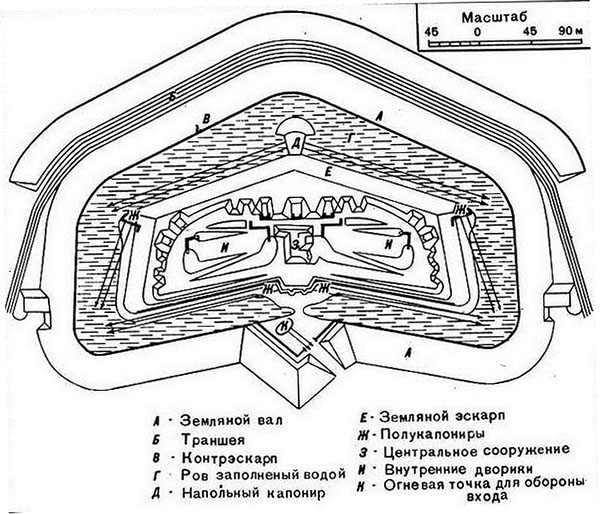
In the spring of 1945, when the city was stormed by the Red Army, the forts of Königsberg took part in military operations for the first and last time in their history. And despite their venerable age, they still remained a tough nut to crack .
During the assault on Königsberg in April 1945, they drew off considerable forces and resources from the armies of the 3rd Belorussian Front advancing on the city. Fort No. 5 withstood the longest siege of all the forts. It was located in the direction of the main attack of the 43rd Army and offered the fiercest resistance to our troops.
Construction of Fort No. 5 began in 1878. The artillery located on the battle rampart of the fort was supposed to cover the road to Pillau (Baltiysk), the naval base, as well as Rauschen (Svetlogorsk) and Kranz (Zelenogradsk) with its fire.
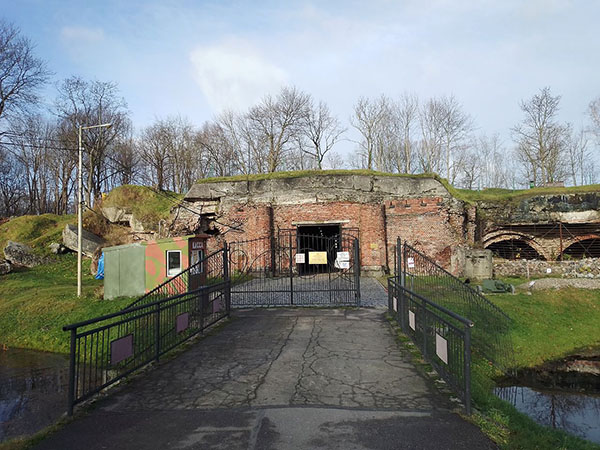
Its garrison consisted of 250-300 people: one infantry company, an artillery team and two sapper squads. The fort was armed with: 37 mm caliber revolver cannons , 90, 120, 150 mm caliber guns, and 210 mm mortars (22 guns in total).
Each main fort was built for 4-5 years, had its own serial number and was named after a nearby settlement. But since 1894, upon completion of construction, all defensive structures were named in honor of Prussian kings or outstanding figures. Thus, Fort No. 5, which was one of the main ones, was originally called "Charlottenburg", and then received the name "King Friedrich Wilhelm III " ( during the war with Napoleon, the King of Prussia Friedrich Wilhelm III was an ally of Russia in the anti-Napoleonic coalition and was the husband of the beautiful Queen Louise, whose name is borne by Fort No. 6 - the only one named after a woman).
The central structure of the fort is a hexagon. It is surrounded on all sides by an artificial water moat up to 25 meters wide and about 4 meters deep. The central structure, measuring 215 by 105 meters, is located symmetrically relative to the main postern, an underground corridor for communication between different parts of the fort. From the rear side, which is called the "gorge", the fort was connected to the adjacent territory by a drawbridge across the moat. At the corners of the fort are caponiers - combat structures with embrasures from which fire is conducted to prevent the enemy from crossing the moat.
The fort itself is built from special multiple-fired brick. The walls are 2 meters thick. The ceiling consists of several tiers of brick floors reinforced with a concrete "cushion" and covered with a layer of soil on top. The ceiling above the central entrance to the fort has additional anti-splinter reinforcement in the form of metal beams.
Each such defensive structure was supposed to withstand a long siege. Therefore, in the central structure of the fort there were food warehouses, drinking wells, powder magazines, ammunition warehouses, assembly laboratories, guard rooms and a stable. In the rear part there were barracks (heated rooms for the garrison to rest in wartime), kitchens, hospitals and soldiers' toilets with a cesspool .
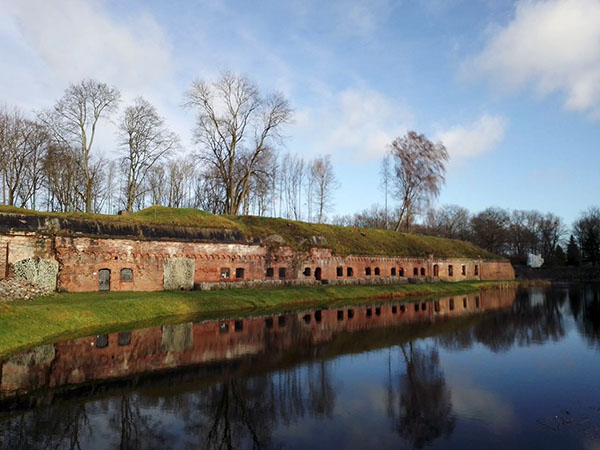
At the corners of the fort were caponiers - structures with loopholes designed to conduct flanking (or dagger) fire at an enemy attempting to cross the ditch.
The evolution of artillery was so rapid that as soon as the construction of the forts was completed, they began to rapidly become obsolete. The forts of Königsberg did not take part in World War I.
But in the late 1930s, wire communication lines were laid inside and outside the 5th fort, the fort was electrified. A line was extended to the city, and a diesel generator was installed.
The German command seriously remembered the forts after the defeat at Stalingrad. And from the autumn of 1944, intensive work began to strengthen the city's defenses and create a field fortification system, traces of which have survived around the city to this day.
The German command paid great attention to strengthening Königsberg. It was prepared for long-term resistance even in conditions of complete isolation.
A number of defensive positions were created around the city, the basis of which were field-type fortifications that supplemented and strengthened the existing permanent structures. Each position was built with the calculation of the circular defense of Königsberg.
At 8-15 kilometers from the city center there was a position that the Germans considered the outer perimeter. This position consisted of several trenches, in front of which engineering obstacles were installed. By the beginning of the assault on April 6, 1945, the outer defensive perimeter was captured by our troops.
The first position was located 6-8 kilometers from the city center. It included 2-3, and in some places 6-7 trenches, connected by a large number of communication passages, as well as 15 forts, each of which housed a garrison of 250-300 people.
The second position was located directly on the outskirts of the city, 3-4 kilometers from the center. The basis of the defense here were strong stone buildings adapted for defense. The Germans barricaded the streets, built reinforced concrete firing points at their intersections, mined the outskirts, and installed a large number of anti-tank and assault guns.
The third position was in the city itself - along the old city line. Now these are the streets Litovsky Val, Kalinina Avenue, Gvardeysky Avenue, Zheleznodorozhnaya. There were 9 permanent structures here. The city blocks were also fortified and adapted for defense.
The Königsberg garrison on April 5, according to some estimates, numbered up to 130 thousand people, armed with about 2 thousand guns and mortars, 28 tanks and 80 assault guns. The enemy could use up to 170 aircraft, which were based at the airfields of the Samland Peninsula.
The Red Army command took into account the complexity of the field defense, the thickness of the walls and roofs of the forts. That is why a powerful artillery preparation was carried out before the assault. For three days, from April 3 to 6, 1945, the forts were attacked by large and special-power guns of 280 mm and 305 mm caliber. The ceilings of the forts mostly withstood the shelling. Several forts in the north and southwest had to be taken by storm.
On the flanks of the 5th fort, an anti-tank ditch, trenches and artillery positions were dug, antitank obstacles were installed, the entire adjacent space was entangled with barbed wire and mined. Directly in front of the fort ditch, a full-profile trench was dug with rifle cells extended 4-5 meters. At a distance of 20-30 meters from the line of trenches, there were "Bruno spirals" of ring barbed wire in two or three rows horizontally and vertically, as well as a "German fence" consisting of two or three rows of barbed wire on metal stakes and wooden "hedgehogs". Further on there was an anti-tank ditch, and behind it - anti-tank and anti-personnel minefields.
By the beginning of April 1945, Fort No. 5 was in the direction of attack of the 43rd Army of General Beloborodov, which was part of the 3rd Belorussian Front under the command of Marshal of the Soviet Union Vasilevsky.
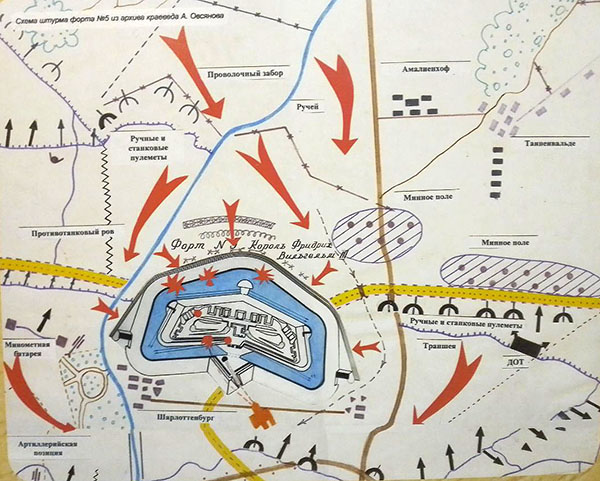
The 5th fort was completely blocked already on April 6, but the first assault on the night of April 7 failed. It was then that the crew of a high-power 280 mm caliber gun (the weight of one shell of this gun was about 250 kg) under the command of Lieutenant A.B. Rastikhin received the task of bypassing the fort and destroying the concrete pillbox covering the gorge bridge - the only way into the fort. On April 8, after several shots, the pillbox was partially destroyed. Subsequently, it was blown up again by sappers.
The ruins of this pillbox, the thickness of the walls of which reached 2 meters, can now be seen to the left of the entrance to the fort.
Two shells hit the fort itself. In the upper left corner above the central gate there is a breach - a trace of the first shell hitting. And on the left side of the gate there are ruins - the result of the second shell hitting the ammunition depot. This shell did not explode, but our sappers then had to destroy the depot on the spot.
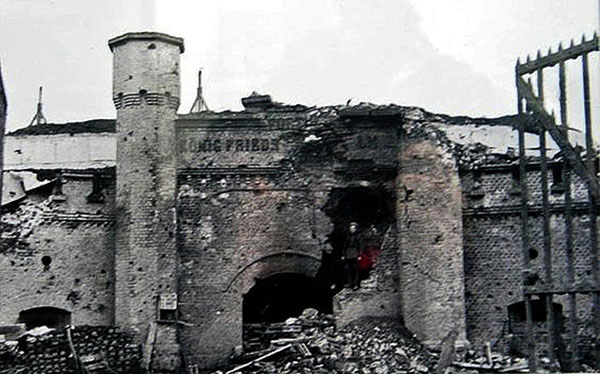
As a result of the shelling, the fort's garrison suffered losses in personnel, and some of the artillery guns installed on the battle rampart were destroyed or disabled. But the Germans continued to put up fierce resistance, the longest of all 15 Königsberg forts.
After the shots were fired at the fort gates, the garrison raised a white flag. But a little later it turned out that by that time a battle had been going on inside the fort for several hours: while Rastikhin was "walking" around, from the opposite side, through the embrasure of the floor caponier, Lieutenant Babushkin's assault detachment penetrated the fort and started a battle inside the fort. For several hours, the Red Army soldiers fought with the enemy soldiers for every corridor and for every casemate.
Following the battles for Fort No. 5, 15 Soviet soldiers were awarded the highest degree of the USSR distinction – the title Hero of the Soviet Union. Their names are inscribed on a granite obelisk erected at the entrance to the fort in 1973.
